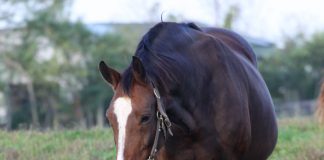In certain parts of the U.S., particularly the western states, drought often causes a hay shortage, or at the very least has a huge impact on horse owners’ wallets as demand for short supply escalates hay prices. Are there fiber-based products you can use to supplement hay?

Hay cubes (grass or alfalfa)
One of the first things you can use when there is a hay shortage are hay cubes. Hay cubes are often available even when bales of hay aren’t. These can be purchased at the feed store as 50-pound bags and fed pound per pound (weigh it!) as you’d feed hay. If your horse isn’t used to alfalfa, then ease him into it gradually, and even better, only feed a proportion of his diet as alfalfa cubes, simply as a supplement to hay. These cubes also generate less waste than hay.Alfalfa pellets and/or complete feed pellets
These serve as a good substitute for hay when there is a shortage, but they will be consumed quickly, giving your horse long fasting periods. Again, be cautious with alfalfa-based feed if a horse isn’t used to it, and use pelleted feeds only as a supplement.
Soaked beet pulp pellets
Another substitute when there is a hay shortage are soaked beet pulp pellets. These an excellent source of fiber and calories. Beware of feeding beet pulp to horses with metabolic problems, especially if it contains molasses. For young, growing horses, beet pulp is high in calcium, which could imbalance the calcium to phosphorus ratio, which is critical to normal musculoskeletal development. Consult with your vet about the use of beet pulp for young horses.
Haylage
In some parts of the country, haylage is available. This is a form of chopped hay much like silage fed to cattle. Because it has 25 to 50 percent more water in it than hay, you’ll need to adjust amounts, often feeding 1-¼ to 1-½ times as much haylage as you would hay, pound for pound. It’s useful for reducing dust and mold spores for horses with inflammatory airway disease. This high-moisture, highly fermentable feed should be used with the cautionary advice of your veterinarian. Haylage is packaged in plastic that keeps out oxygen, thereby promoting the growth of anaerobic bacteria, such as botulism. Mold also proliferates in haylage once the bags are opened. Only feed haylage that has been produced, preserved and stored properly, and be sure to immunize a horse that eats haylage against botulism.
Compressed Hay
Commercial feed companies have produced a compressed hay block that reconstitutes into large amounts when water is added. It is not meant as a complete hay alternative because one block, weighing in at 2 pounds, expands only to a flake of hay, and these blocks are quite expensive. The hay blocks do serve a purpose, however: they are handy for traveling and for increasing water intake in a horse’s diet.
The key is to use these alternative fiber substances as supplements to stretch existing hay sources when there is a shortage, and not as complete substitutes.
The Benefits
With some common sense and creativity, you can find ways to feed your horse more in keeping with his natural tendencies. The ability to eat small, intermittent meals throughout the day will also work wonders on your horse’s mental health and behavior. These suggestions are starting points, which can be fine-tuned for your individual horse’s needs.
Read more about feeding horses without pasture.
This article originally appeared in the February 2015 issue of Horse Illustrated magazine. Click here to subscribe!






